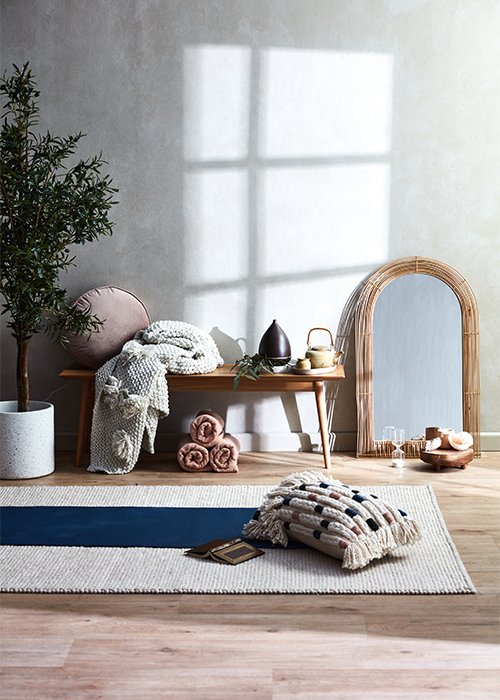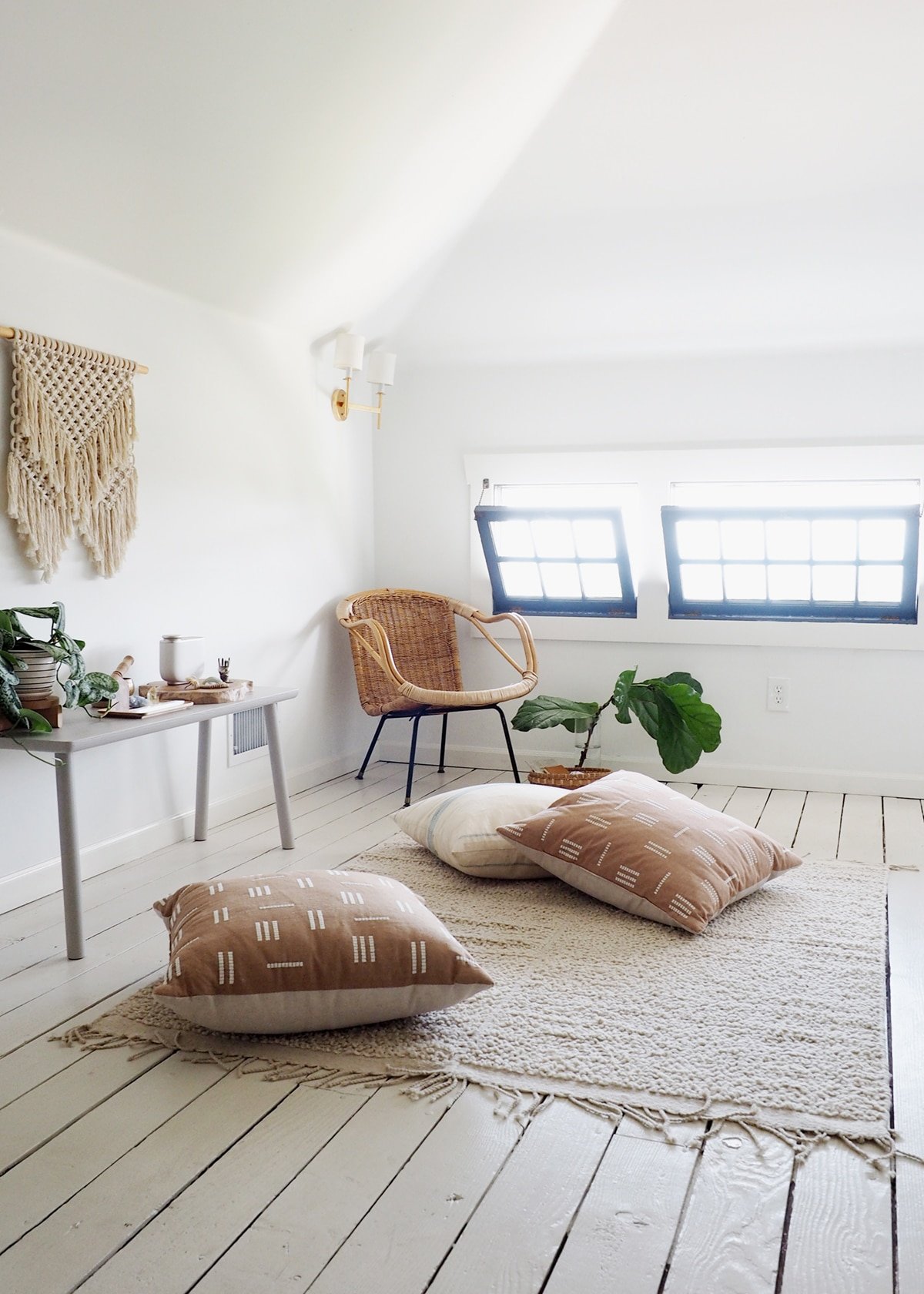How to create a tranquil meditation room
With so much stress and pressure in our daily lives whether it’s a hectic job, home and family responsibilities, or both, having spaces for mindfulness has never been more important.
Have you always wanted a sanctuary in your home to center yourself and disconnect for a while? Then you may be in need of a meditation space. Whether you have a full room you can transform or just a small nook, we’ve got expert tips so you can design the perfect meditation and mindfulness space in your home.
Decoist
We suggest that everyone should create a space in their homes for daily meditation; a space that provides you with the opportunity to recharge your body both physically and mentally, and keep you balanced. The benefits of meditation are still being uncovered, but all discoveries to date show that meditation has a rich healing, transformative power like no other. Some studies have shown that meditation actually has the power to change the way our brains work.
While there is not a specific set of rules that need to be followed when creating a meditation room, there are some things you should take into consideration. Take some inspiration from the following ten ways to create your own mediation room, but most importantly, follow your mind and heart, only putting in elements you love—elements that create a personal feeling of zen-like bliss.
Swatta
What Are the Benefits of Meditation?
If you don’t already practice meditation regularly you might be wondering – what is meditation and what are the benefits?
In short, meditation is the practice of quieting and centering your mind. It helps you avoid the stream of chaotic thoughts that we often find ourselves bombarded with. The types of thoughts that often cause anxiety and stress.
At a basic level meditation can give you a sense of calm and peace that then will translate to emotional and physical benefits. These include:
Reducing stress and negative emotions
Increasing self-awareness
Boosting imagination and creativity
Increasing patience
Improving sleep
Brek Life Group
Beyond these initial benefits, meditation can also help manage the symptoms of common medical conditions including:
Asthma
Anxiety
Insomnia
Headaches
Chronic pain
Irritable bowel syndrome
Depression
Heart disease
High blood pressure
Cancer
These benefits do vary by individual. It’s important to note that meditation isn’t a cure-all and shouldn’t be thought of as a replacement for traditional medical care, but if you think it may help with a medical condition then you should consult with your doctor if it's something you should try (Mayoclinic).
The Spruce
How to Design a Meditation Space In Your Home
Now that you know the benefits of meditation, you may be ready to create a meditation area in your home where you can practice mindfulness. For all about how to make that a reality, keep reading for our expert advice.
Unplug and Declutter
First things first, your meditation space should be calm and distraction-free. This means you’ll want to get rid of any clutter.
If you don’t have a spare room to dedicate to your mindfulness space, no problem. Even just a nook or corner in your home can be set up for meditation. Be sure that you carve out space in a clean and empty area. Stay clear from using a high-traffic space or one that’s already used for sleeping, cooking, or working.
Also, consider making your meditation area a technology-free zone. This means no phones, tablets, or TVs. If you need a device because you use a meditation app for your practice, or to play music, make sure that it’s the only app you use in the space and silence all other notifications like email, texts, calls, or social media. This is so you can be fully present for your meditation and avoid anything that’ll derail your practice.
Temple and Webster
Select a Soft and Serene Color Pallet
When choosing a color scheme for the room think about what colors make you feel calm and relaxed. Soft earth tones or pastels tend to work best. Some prefer darker earth tones which can make the atmosphere feel intimate and cozy. This is a personal preference, just think about what will make you feel most serene.
Even if you like a lot of color and have more color incorporated throughout your home, for a meditation space it’s best to avoid anything too bright or energizing, like bold reds, yellows, or oranges. If you’d like to include these colors in accents make sure they’re soft and more muted tones.
For more on this subject, read about color psychology in design and the effects of color on your mood and emotions.
dwell
Bring in Natural Elements
There have been many studies that reveal that nature has a positive impact on our well-being. Some of the benefits include less stress, a better mood, and greater creativity and productivity. Proponents of biophilic design strive to incorporate connections to nature in our interiors.
You’ll want to adopt this same mindset when designing your meditation space. As nature is very healing and can help you feel refreshed and invigorated. There are a number of ways you can design your meditation space with nature in mind.
Select a space that has access to windows so you can have a view, fresh air, or natural light while you meditate. Also, think of incorporating a fountain or water feature so you can enjoy running water sounds.
Include plants and greenery to feel more connected to nature. Having plants indoors has so many benefits. They help detoxify and purify the air, and as meditation often involves deep breathing having good air quality in this space is a must. You might also want to consider fragrant plants or floral bouquets that emit soothing scents to enhance your meditation experience.
Or better yet, if you have an outdoor area you can turn it into a meditation studio, it will allow you to connect with nature all the more.
Cassandra Lavalle
Experiment with Aromatherapy
While you want to keep things comfortable and visually calm in the space, think about your other senses as well. What do you want your meditation space to smell like? What scents help you feel relaxed and calm?
Plants and fresh flowers are great for this but also think about introducing aromatherapy into your meditation practice.
If you’re not already familiar, aromatherapy is a holistic healing treatment using natural plant oils to promote health and well-being (Healthline). Aromatherapy can be used to:
Manag chronic pain or illness
Improve sleep
Reduce stress and anxiety
Boost immune system
If you’d like to include aromatherapy in your meditation space, you can do so with candles, incense, or essential oils in a diffuser. There are plenty of scents to choose from, but some of the most soothing are lavender, chamomile, and peppermint.
Healthline has a helpful list of the top 10 essential oils and the benefits associated with each. So you can select the oils that best fit your priorities.
Dwell
Keep the Look Minimal
Because you want to create a space that feels zen, you’ll want to keep the decor minimalistic. You don’t want too much going on visually to distract you while you’re meditating.
Think less is more and keep furniture accent items to the essentials. You may only want to include an area rug, cushions or pillows, a console table if needed for storage, and a few plants. Really keep it pared back and avoid over-decorating.
Dwell
Prioritize Comfort and the Personal
You’ll want to ensure the space is comfortable and this is different for everyone. For some, a mat on the floor feels best. For others, it may be a spot with plush pillows and cushions. Or even a sofa where you can comfortably lie down. This will all depend on your personal preference.
Though you want to keep the design minimal, you also may want to think about including items to make the space feel personal to you. This could be an object or photograph that brings you joy or relaxation. Or you may like to include chimes, crystals, affirmation stones, or artwork that help enhance your meditative practice and get you into the right state of mind.
If you want to adopt some of these design ideas throughout your entire home. Check out our article on how to make your home feel like a grounded retreat.
Need help from a knowledgeable and experienced interior designer? Let AHG Interiors take on the design, details, and execution for you. We create personal and custom spaces to fit your unique needs. Contact us today to tell us about your project.
Dwell










